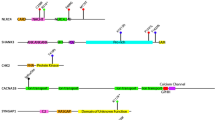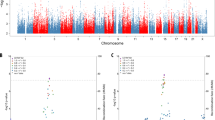Abstract
Neurotensin (NT) is an endogenous tridecapetide1 cleaved from a precursor proneurotensin/ proneuromedin protein. NT localises within dopaminergic neurones in the mesocortical, mesolimbic and nigrostriatal systems1, 2, 3 and it is now clear that NT can selectively modulate dopaminergic neurotransmission.2, 3, 4, 5, 6, 7, 8, 9 These anatomical and functional connections have led to the hypothesis that NT dysfunction might contribute to the pathogenesis of neuropsychiatric disorders in which disordered dopaminergic neurotransmission is suspected, particularly schizophrenia.3 The latter hypothesis has been supported circumstantially by the observation that central administration of NT produces effects similar to those produced by the peripheral administration of atypical antipsychotics,10, 11 and more directly by studies showing levels of NT in cerebral spinal fluid (CSF) is lower in schizophrenics than in controls.12, 13 To allow such hypotheses to be tested, we used denaturing high performance liquid chromatography (DHPLC)14 to identify three sequence variants in the neurotensin gene (NTS) that might alter NT structure or expression. However, using a case-control study design and a novel genotyping system based upon a primer extension protocol and HPLC detection,15 we found no evidence to support the hypothesis that variation in the proneurotensin gene contributes to susceptibility to schizophrenia.
This is a preview of subscription content, access via your institution
Access options
Subscribe to this journal
Receive 12 print issues and online access
$259.00 per year
only $21.58 per issue
Buy this article
- Purchase on Springer Link
- Instant access to full article PDF
Prices may be subject to local taxes which are calculated during checkout


Similar content being viewed by others
References
Mai J, Triepel KJ, Metz J . Neurotensin in the human brain Neuroscience 1987; 22: 499–524
Quirion R . Interactions between neurotensin and dopamine in the brain: an overview Peptides 1983; 4: 609–615
Nemeroff CB . The interaction of neurotensin with dopaminergic pathways in the central nervous system: basic neurobiology and implications for the pathogenesis and treatment of schizophrenia Psychoneuroendocrinology 1986; 11: 15–37
Bean AJ, Dagerlind A, Hokfelt T, Dobner PR . Cloning of human neurotensin/neuromedin N genomic sequences and expression in the ventral mesencephalon of schizophrenics and age/sex matched controls Neuroscience 1992; 50: 259–268
Lambert PD, Gross R, Nemeroff CB, Kilts CD . Anatomy and mechanisms of neurotensin-dopamine interactions in the central nervous system Ann New York Acad Sci 1995; 757: 377–389
Sotty F, Souliere F, Brun P, Chouvet G, Steinberg R, Soubrie P et al. Differential effects of neurotensin on dopamine release in the caudal and rostral nucleus accumbens: a combined electrochemical and electrophysiological study Neuroscience 1998; 85: 1173–1182
Liu Y, Hillefors-Berglund M, Von Euler G . Modulation of dopamine D3 receptor binding by N-ethylmaleimide and neurotensin Brain Res 1994; 643: 343–348
Azzi M, Betancur C, Sillaber I, Spanagel R, Rostene W, Berod A . Repeated administration of the neurotensin receptor antagonist SR 48692 differentially regulates mesocortical and mesolimbic dopaminergic systems J Neurochem 1998; 71: 1158–1167
Kasckow J, Nemeroff CB . The neurobiology of neurotensin-focus on neurotensin-dopamine interactions Regul Peptides 1991; 36: 153–164
Nemeroff CB, Levant B, Myers B, Bissette G . Neurotensin, antipsychotic drugs and schizophrenia Ann New York Acad Sci 1992; 668: 146–156
Nemeroff CB . Neurotensin, perchance an endogenous neuroleptic? Biol Psychiatry 1980; 15: 283–302
Sharma RP, Janicak PJ, Bissette G, Nemeroff CB . CSF neurotensin concentrations and antipsychotic treatment in schizophrenia and schizoaffective disorder Am J Psychiatry 1997; 154: 1019–1021
Garver DL, Bissette G, Yao JK, Nemeroff CB . Relation of CSF neurotensin concentrations to symptoms and drug response of psychotic patients Am J Psychiatry 1991; 148: 484–488
Underhill PA, Jin L, Lin AA, Mehdi SQ, Jenkins T, Vollrath D et al. Detection of numerous Y chromosome biallelic polymorphisms by denaturing high performance liquid chromatography Genome Res 1997; 7: 996–1005
Hoogendoorn B, Owen M, Oefner PJ, Williams N, Austin J, O'Donovan MC . Genotyping single nucleotide polymorphisms by primer extension and high performance liquid chromatography Hum Genet 1999; 104: 89–93
Marondel I, Renault B, Lieman J, Ward D, Kucherlapati R . Physical mapping of the human neurotensin gene (NTS) between markers D12S1444 and D12S81 on chromosome 12q21 Genomics 1996; 38: 243–245
Sobell JL, Heston LL, Sommer SS . Delineation of genetic predisposition to multifactorial disease: a general approach on the threshold of feasibility Genomics 1992; 12: 1–6
O'Donovan MC, Oefner PJ, Roberts SC, Austin J, Hoogendoorn B, Guy C et al. Blind analysis of denaturing high performance liquid chromatography as a tool for mutation detection Genomics 1998; 52: 44–49
Jones A, Austin J, Hansen N, Hoogendoorn B, Oefner PJ, Cheadle JP et al. Optimal temperature selection for mutation detection by denaturing high performance liquid chromatography and comparison to SSCP and heteroduplex analysis Clin Chem 1999; 45: 1133–1140
American Psychiatric Association . Diagnostic and Statistical Manual of Mental Disorders (4th edn) American Psychiatric Association: Washington DC 1994
McGuffin P, Farmer A, Harvey I . A polydiagnostic application of operational criteria in studies of psychotic illness. Development and reliability of the OPCRIT system Arch Gen Psychiatry 1991; 48: 764–770
Wing JK, Babor T, Brugha T, Burke J, Cooper JE, Giel R et al. SCAN: Schedules for clinical assessment in neuropsychiatry Arch Gen Psychiatry 1990; 47: 589–593
Wing JK, Cooper JE, Sartorius N . Measurement and Classification of Psychiatric Symptoms Cambridge University Press: Cambridge 1972
Owen MJ, Holmans P, McGuffin P . Association study in psychiatric genetics Mol Psychiatry 1997; 2: 270–273
Krawczak M, Konecki DS, Schmidtke J, Dück M, Engel W, Nützenadel W et al. Allelic association of the cystic fibrosis locus and two DNA markers, XV2c and KM19, in German families Hum Genet 1998; 80: 78–80
Lewontin RC . The interaction of selection and linkage. I. General considerations; heterotic models Genetics 1964; 49: 49–67
Devlin B, Risch N . A comparison of linkage disequilibrium measures for fine-scale mapping Genomics 1995; 29: 311–322
Acknowledgements
This study was supported by a grant from the Wellcome Trust (Ref 052309). J Austin is funded by a University of Wales College of Medicine Studentship. Grateful thanks to Paul R Dobner, PhD for kindly providing intronic sequence for NTS to allow primer design. We are very grateful for the practical help we received from Professor Michael Krawczak on the use of his HAPMAX program and the advice given on interpretation of its output.
Author information
Authors and Affiliations
Corresponding author
Rights and permissions
About this article
Cite this article
Austin, J., Hoogendoorn, B., Buckland, P. et al. Comparative sequencing of the proneurotensin gene and association studies in schizophrenia. Mol Psychiatry 5, 208–212 (2000). https://doi.org/10.1038/sj.mp.4000693
Received:
Revised:
Accepted:
Published:
Issue Date:
DOI: https://doi.org/10.1038/sj.mp.4000693
Keywords
This article is cited by
-
Association Between Neurotensin Receptor 1 (NTR1) Gene Polymorphisms and Schizophrenia in a Han Chinese Population
Journal of Molecular Neuroscience (2013)
-
Evidence for rare and common genetic risk variants for schizophrenia at protein kinase C, alpha
Molecular Psychiatry (2010)
-
A functional polymorphism in the succinate-semialdehyde dehydrogenase (aldehyde dehydrogenase 5 family, member A1) gene is associated with cognitive ability
Molecular Psychiatry (2004)
-
Determination of the genomic structure and mutation screening in schizophrenic individuals for five subunits of the N-methyl-D-aspartate glutamate receptor
Molecular Psychiatry (2002)
-
Mutation screening of the KCNN3 gene reveals a rare frameshift mutation
Molecular Psychiatry (2001)



